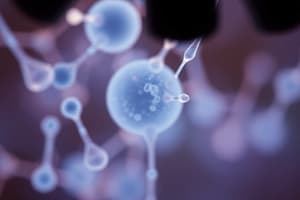Podcast
Questions and Answers
A light microscope can magnify images effectively up to 2,000 times the actual size of the specimen.
A light microscope can magnify images effectively up to 2,000 times the actual size of the specimen.
False (B)
Scanning electron microscopes provide images that look two-dimensional.
Scanning electron microscopes provide images that look two-dimensional.
False (B)
Centrifugation is a technique used to separate major organelles from one another in cell fractionation.
Centrifugation is a technique used to separate major organelles from one another in cell fractionation.
True (A)
Cryo-electron microscopy is primarily used to study the surface features of specimens.
Cryo-electron microscopy is primarily used to study the surface features of specimens.
Resolution in microscopy refers to the measure of how close two distinguishable points can be.
Resolution in microscopy refers to the measure of how close two distinguishable points can be.
Eukaryotic cells contain a nucleus that houses their DNA.
Eukaryotic cells contain a nucleus that houses their DNA.
Prokaryotic cells have membrane-bound organelles.
Prokaryotic cells have membrane-bound organelles.
The cell wall is a structure found in animal cells but not in plant cells.
The cell wall is a structure found in animal cells but not in plant cells.
Ribosomes are responsible for protein synthesis in all cells.
Ribosomes are responsible for protein synthesis in all cells.
Fimbriae are structures found on prokaryotic cells that are used for attachment.
Fimbriae are structures found on prokaryotic cells that are used for attachment.
Flashcards are hidden until you start studying
Study Notes
Microscopy
- Scientists use microscopes to visualize cells too small to see with the naked eye.
- Light microscopes (LMs) pass visible light through a specimen and then through glass lenses, magnifying the image by bending the light.
- Key parameters of microscopy include magnification, resolution, and contrast.
- Magnification is the ratio of an object's image size to its real size.
- Resolution measures image clarity and is the minimum distance between two distinguishable points.
- Contrast refers to visible differences in parts of the sample.
- LMs can magnify objects effectively up to 1,000 times their actual size.
- Techniques like staining and labeling enhance contrast and reveal cell components.
- Most subcellular structures, including organelles, are too small to be resolved by LMs.
- Advanced light microscopy techniques, like confocal microscopy and deconvolution microscopy, provide sharper images of 3-D tissues and cells.
- New cell labeling techniques improve resolution.
Electron Microscopes (EMs)
- Two types of electron microscopes (EMs), scanning electron microscopes (SEMs) and transmission electron microscopes (TEMs), are used to study subcellular structures.
- SEMs focus a beam of electrons onto the surface of a specimen, creating 3-D-like images.
- TEMs focus a beam of electrons through a specimen.
- Cryo-electron microscopy (cryo-EM) uses a beam of electrons to visualize molecules.
- TEMs are primarily used to study the internal structure of cells.
Cell Fractionation
- Cell fractionation separates major organelles from each other by breaking cells apart.
- Centrifuges are used to fractionate cells into their component parts.
- Cell fractionation helps scientists determine the functions of organelles.
- Biochemistry and cytology correlate cell function with structure.
Comparing Prokaryotic and Eukaryotic cells
- The basic structural and functional unit of every organism is either a prokaryotic or eukaryotic cell.
- Organisms in the domains Bacteria and Archaea consist of prokaryotic cells.
- Protists, fungi, animals, and plants all consist of eukaryotic cells.
- All cells share basic features:
- Plasma membrane
- Semifluid substance called cytosol
- Chromosomes (carry genes)
- Ribosomes (make proteins)
- Prokaryotic cells are characterized by:
- Absence of a nucleus
- DNA located in an unbound region called the nucleoid
- Lack of membrane-bound organelles
- Cytoplasm bound by the plasma membrane.
Eukaryotic Cells
- Eukaryotic cells have internal membranes that compartmentalize their functions.
- These components either directly connect or communicate through vesicles for transfer.
The Endoplasmic Reticulum: Biosynthetic Factory
- The endoplasmic reticulum (ER) accounts for more than half of the total membrane in many eukaryotic cells.
- The ER membrane is continuous with the nuclear envelope.
- There are two distinct regions of the ER:
- Smooth ER, lacking ribosomes.
- Rough ER, studded with ribosomes on its surface.
Functions of Smooth ER
- Synthesizes lipids.
- Metabolizes carbohydrates.
- Detoxifies drugs and poisons.
- Stores calcium ions.
Functions of Rough ER
- Has bound ribosomes, which secrete glycoproteins (proteins bound to carbohydrates).
- Distributes transport vesicles (membrane-bound proteins).
- Serves as a membrane factory for the cell.
The Golgi Apparatus: Shipping and Receiving Center
- Consists of flattened membranous sacs called cisternae.
- It modifies ER products, manufactures certain macromolecules, and sorts and packages materials into transport vesicles.
Lysosomes: Digestive Compartments
- Lysosomes are membrane-bound sacs containing hydrolytic enzymes that digest macromolecules.
- Lysosomal enzymes can hydrolyze proteins, fats, polysaccharides, and nucleic acids.
- These enzymes work best in the acidic environment inside lysosomes.
Lysosomes: Digestion of Macromolecules
- Some cells engulf other cells by phagocytosis, forming food vacuoles.
- A lysosome fuses with the food vacuole and digests the molecules.
- Lysosomes also use enzymes to recycle the cell’s own organelles and macromolecules, a process called autophagy.
Vacuoles: Diverse Maintenance Compartments
- Plant and fungal cells may have one or several vacuoles, derived from the ER and Golgi apparatus.
- Food vacuoles are formed by phagocytosis.
- Contractile vacuoles, found in many freshwater protists, pump excess water out of cells.
- Central vacuoles, found in many mature plant cells, hold organic compounds and water.
The Plant Cell Vacuole
- Contains a large central vacuole, often taking up the majority of the cell's volume.
Mitochondria: Cellular Respiration
- Convert chemical energy stored in food into a form that cells can use for work, via cellular respiration.
- Have two membranes: an outer membrane and an inner membrane folded into cristae.
- The inner membrane encloses the mitochondrial matrix.
- Contain their own DNA.
Chloroplasts: Capture of Light Energy
- Contain the green pigment chlorophyll, as well as enzymes and other molecules involved in photosynthesis.
- Found in the leaves and other green organs of plants and algae.
- Have a structure that includes:
- Thylakoids, membranous sacs, stacked to form a granum.
- Stroma, the internal fluid.
- They are one of a group of plant organelles called plastids.
The Chloroplast, Site of Photosynthesis
- The thylakoids are the sites of light-dependent reactions.
- The stroma is the site of the Calvin cycle (light-independent reactions).
- Contain their own DNA.
Peroxisomes: Oxidation
- Specialized metabolic compartments bounded by a single membrane.
- Produce hydrogen peroxide and convert it to water.
- Perform reactions with a variety of functions.
- Their relationship to other organelles is still under investigation.
The Cytoskeleton: A Network of Fibers that Organizes Structures and Activities in the Cell
- Extends throughout the cytoplasm, organizing the cell’s structures and activities.
- Anchors many organelles.
- Composed of three types of molecular structures:
- Microtubules
- Microfilaments
- Intermediate filaments
Studying That Suits You
Use AI to generate personalized quizzes and flashcards to suit your learning preferences.




